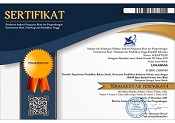Model Explicit Intruction dalam Materi Kawih Sunda
Abstract
This research is motivated by the lack of students' abilities in Sundanese. The purpose of this study is to describe the ability of ngawih before and after using the Explicit Intruction model, whether or not increasing after using the Explicit Intruction model, as well as describing the difference between the ngawih ability before and after using the Explicit Intruction model. The method used in this study is a quasi-experimental method, to students of class XI KPU-2 SMK Negeri 12 Bandung by using a pre-test and post-test design. Based on the results of research conducted, the average before using the Explicit Intruction model is (30.14) which proves that students are not capable of being incompetent, while the average after using the Explicit Intruction model is (75.88) which proves students are capable of being incompetent. Based on the statistical test results the significance value (Sig.2-tailed) is (0,000 <0.5) or less than 0.5. Thus, H1 is accepted and H0 is rejected. This means that there is a significant difference between the ability to appear before and after using the Explicit Instruction model. This shows that the Explicit Intruction learning model can improve the Sundanese ngawih ability of class XI KPU-2 students of SMK Negeri 12 Bandung in Academic Year 2018/2019.
Abstrak
Penelitian ini dilatarbelakangi oleh kurangnya kemampuan siswa dalam ngawih Sunda. Tujuan dari penelitian ini adalah untuk mendeskripsikan kemampuan ngawih sebelum dan setelah menggunakan model Explicit Intruction, meningkat atau tidaknya setelah menggunakan model Explicit Intruction, serta mendeskripsikan perbedaan antara kemampuan ngawih sebelum dan setelah menggunakan model Explicit Intruction. Metode yang digunakan dalam penelitian ini yaitu metode kuasi eksperimen, kepada siswa kelas XI KPU-2 SMK Negeri 12 Bandung dengan menggunakan desain pre-test dan post-test. Berdasarkan hasil penelitian yang dilaksanakan, rata –rata sebelum menggunakan model Explicit Intruction adalah (30,14) yang membuktikan bahwa siswa belum mampu ngawih, sedangkan rata-rata setelah menggunakan model Explicit Intruction adalah (75,88) yang membuktikan siswa mampu ngawih. Berdasarkan hasil uji statistika nilai signifikansi (Sig.2-tailed) yaitu (0,000<0,5) atau kurang dari 0,5. Dengan demikian, H1 diterima serta H0 ditolak. Artinya ada perbedaan yang signifikan anatar kemampuan ngawih sebelum dan setelah menggunakan model Explicit Intruction. Hal ini menunjukan bahwa model pembelajaran Explicit Intruction dapat meningkatkan kemampuan ngawih Sunda siswa kelas XI KPU-2 SMK Negeri 12 Bandung Tahun Ajaran 2018/2019.
Keywords
Full Text:
PDFReferences
Arikunto. (2013). Prosedut Penelitian Suatu Pendekatan Praktik. Jakarta: Rineka Cipta.
Aris, S. (2014). 68 Model Pembelajaran Inovatif dalam Kurikulum 2013. Yogyakarta: Ar-Ruzz Media.
Danny, S. (2010). Pengaruh Musik terhadap Konsentrasi Belajar siswa Kelas 2 SMUK 1 Salatiga. Vol. 52(1). Retrieved from https://jurnal.lppmunindra.ac.id.
Dedi, Y. (2016). Pengaruh Penerapan Metode Pembelajaran Resitasi Terhadap Hasil Belajar Matematika Siswa. 2(2), 165-174. Retrieved from http://jurnal.lppmunindrat.ac.id
Emda, A. (2017). Kedudukan Motivasi Belajar Siswa Dalam Pembelajaran. Vol. 5, 172-182. Lantanida Journl. Retrieved from https://jurnal.lppmunindra.ac.id.
Hendrayana, D. (2017). Metode Tiga Langkah Mengajar Bahasa Sunda Dengan Materi Kawih asuh Barudak. Loka Basa, 8(1). 22-29 Retrieved from ejournal.upi.edu/index.php/lokabasa/article/view/15963
Kamsinah. (2018). Metode Dalam Proses Pembelajaran Studi Tentang Ragam dan Implementasinya. 11(1), 101-104 Retrieved from http://journal.uin-alauddin.ac.id/index.php/lentera_pendidikan/article/view/3767.
Nazir, M. (2014). Metode Penelitian. Bogor: Ghalia Indonesia.
Saeful, Agus. (2017). Penerapan Model Pembelajaran Explicit Intruction untuk Meningkatkan Hasil Belajar Siswa Pokok Bahasan Cahaya dan Sifatnya Pada Siswa Kelas V di SD Negeri 1 Sembawa. Vol. 4(1), 1-5 Retrieved from http://jurnal.upmk.ac.id/index.php/lensapendas/article/view/488.
Pramudita, H (2013). Model Supervisi Klinis Pengawas dan MGMP Bahasa Sunda untuk Meningkatkan Kompetensi Guru Bahasa Sunda dalam Merencanakan Pembelajaran. LOKABASA, 4, (1), 67-71. Retrieved from http://ejournal.upi.edu/index.php/lokabasa/article/view/15963
DOI: https://doi.org/10.17509/jlb.v11i1.25161
Refbacks
- There are currently no refbacks.
Copyright (c) 2020 LOKABASA

This work is licensed under a Creative Commons Attribution-ShareAlike 4.0 International License.

This work is licensed under Creative Commons Attribution-ShareAlike 4.0 International License.










